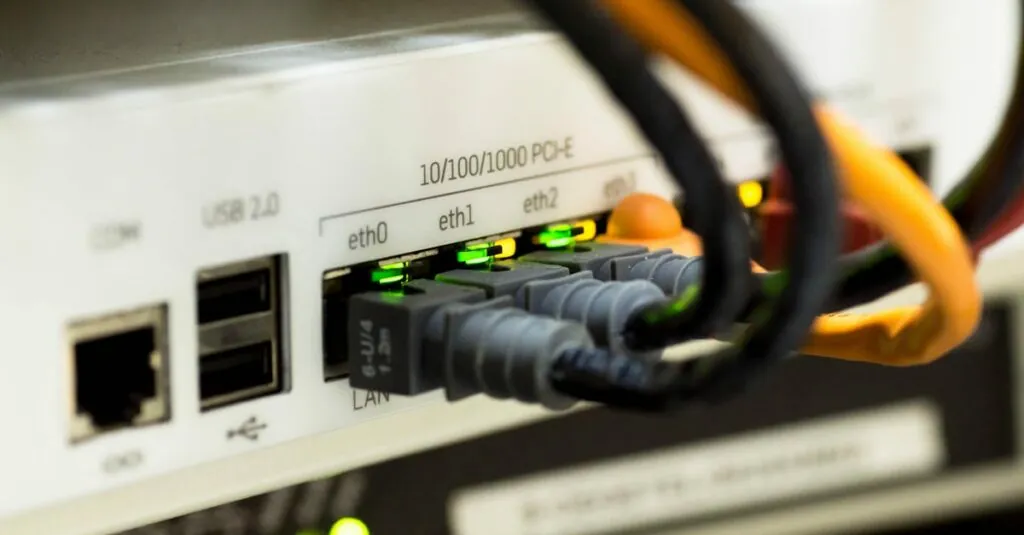In a world where even your toaster might be smarter than your average bear, the Industrial Internet of Things (IIoT) is revolutionizing how industries operate. Imagine machines talking to each other like old pals at a coffee shop, sharing insights and optimizing processes while you sip your morning brew. This isn’t just a futuristic fantasy; it’s happening right now, and it’s changing the game for manufacturers, logistics, and beyond.
From predictive maintenance in factories to smart supply chain management, the examples of IIoT in action are as impressive as they are diverse. Companies are harnessing this technology to boost efficiency, reduce downtime, and save money—because who doesn’t want more cash for that dream vacation? Buckle up as we explore some fascinating examples of the Industrial Internet of Things that’ll have you wondering what other everyday items could use a little tech-savvy upgrade.
Table of Contents
ToggleOverview of Industrial Internet of Things
Industrial Internet of Things (IIoT) connects devices, sensors, and systems within industrial settings. A network of interconnected machines enables real-time data exchange and communication. Manufacturers utilize IIoT to automate processes and enhance productivity.
Applications in predictive maintenance enhance equipment reliability. Companies can analyze sensor data to identify potential issues before they lead to failures. Smart supply chain management also benefits from IIoT solutions. Tracking inventory levels and product movements optimizes logistics and reduces operational costs.
Energy management stands out as another crucial application. Organizations monitor energy consumption in real-time, allowing them to identify inefficiencies. Optimizing energy usage not only cuts costs but also contributes to sustainability goals.
Remote monitoring and control technologies represent significant advancements as well. Operators can oversee machinery from various locations, enabling quick responses to anomalies. This reduces downtime and minimizes disruptions in production.
Data analytics plays a vital role in IIoT effectiveness. By processing large volumes of data, organizations obtain valuable insights that inform decision-making. Integrating artificial intelligence with IIoT further enhances predictive capabilities and automates processes.
Safety improvements emerge through IIoT implementations, too. Real-time monitoring of hazardous environments helps prevent accidents. Workers receive alerts regarding equipment malfunctions, promoting a safer workplace.
Enhanced collaboration among stakeholders occurs via IIoT platforms. Teams can share data insights to drive innovation and improve project management. Engaging with IIoT leads to more effective communication and problem-solving within organizations.
IIoT fundamentally transforms industrial operations, driving efficiency and innovation across various sectors. Its diverse applications show remarkable potential for growth and development in the industry.
Benefits of Industrial Internet of Things
The Industrial Internet of Things (IIoT) brings numerous advantages that significantly enhance industrial operations. Organizations experience considerable improvements in various areas, driving operational success.
Enhanced Efficiency
Machines communicate seamlessly with IIoT technology. Real-time data collection leads to faster decision-making, allowing for optimized production processes. Manufacturers can schedule maintenance more effectively, minimizing unexpected machine failures. Predictive analytics enables organizations to forecast demand accurately, reducing excess inventory. Data insights improve supply chain logistics, leading to lower operational costs. Increased automation further enhances productivity by streamlining repetitive tasks. Overall, IIoT solutions create a more efficient and agile manufacturing environment.
Improved Safety
Safety in the workplace strengthens with IIoT applications. Continuous monitoring of equipment and work environments detects hazardous conditions promptly. Sensors can identify potential risks, allowing for proactive measures. Automated alerts notify staff of safety breaches, so they can respond swiftly. Organizations utilize wearables to monitor employee health in real-time, reducing accidents. Enhanced safety protocols lead to a more secure environment for workers. By prioritizing safety, companies not only protect their employees but also reduce liability costs.
Key Industries Utilizing Industrial Internet of Things
Various industries are harnessing the Industrial Internet of Things (IIoT) to drive innovation and enhance operational efficiency. Key sectors leveraging this technology include manufacturing, supply chain management, and the energy sector.
Manufacturing
Manufacturing stands at the forefront of IIoT adoption. Companies utilize sensor technology to monitor machinery health and streamline production processes. Predictive maintenance strategies allow manufacturers to detect potential equipment failures, thus minimizing downtime. Real-time data contributes to improved quality control and optimized workflows, leading to cost savings. Automation of repetitive tasks also boosts productivity, empowering skilled workers to focus on value-added activities.
Supply Chain Management
Supply chain management benefits greatly from IIoT capabilities. Real-time tracking of goods enhances visibility throughout the supply chain, facilitating quicker decision-making. Companies implement smart sensors to monitor inventory levels, enabling just-in-time restocking and reducing excess stock. Data analytics informs demand forecasting, helping organizations adjust supply strategies. Furthermore, improved communication among stakeholders enhances collaboration, ensuring a more responsive and efficient supply chain.
Energy Sector
The energy sector leverages IIoT for smarter energy management. Smart grids utilize interconnected devices to monitor and optimize energy distribution, resulting in reduced operational costs. Companies track energy usage patterns in real time, identifying inefficiencies and implementing reduction strategies. Remote monitoring of energy assets improves maintenance scheduling, reducing the frequency of outages. This approach promotes sustainability by enabling renewable energy sources to integrate more seamlessly into existing grids.
Notable Industrial Internet of Things Examples
The Industrial Internet of Things (IIoT) showcases numerous applications that enhance industrial operations. These examples illustrate the technology’s transformative potential across various industries.
Smart Factories
Smart factories employ interconnected devices to streamline production. These factories integrate IoT sensors with machinery to collect data in real time. For instance, intelligent systems monitor machine performance, adjusting operations automatically to maintain efficiency. Companies achieve improved yields and reduced waste by optimizing processes through advanced analytics. Data sharing across machines helps operators make informed decisions quickly, enhancing overall productivity. Manufacturers benefit from faster production cycles and better resource allocation by leveraging these capabilities effectively.
Predictive Maintenance
Predictive maintenance significantly improves equipment reliability in industrial settings. Sensors monitor machinery conditions continuously, identifying potential issues before they escalate. Companies can schedule repairs effectively, minimizing unexpected downtime and extending equipment lifespan. For example, data analytics identify wear patterns, prompting maintenance actions when necessary. Cost savings occur as companies avoid major repairs and operational disruptions. Organizations reduce maintenance costs while ensuring optimal performance by proactively managing maintenance schedules and leveraging data insights.
Asset Tracking Solutions
Asset tracking solutions provide real-time visibility in supply chain management. Sensors track the location and condition of assets as they move through the supply chain. Companies leverage IoT technology to monitor inventories efficiently, reducing losses and ensuring timely deliveries. For instance, smart tags send alerts when assets are at risk of being misplaced or damaged. Enhanced tracking capabilities lead to improved coordination among stakeholders, promoting transparency. Businesses enhance decision-making and efficiency by utilizing accurate asset information throughout the logistics process.
Future Trends in Industrial Internet of Things
The future of the Industrial Internet of Things (IIoT) holds immense potential for innovation. A significant trend involves the integration of edge computing, allowing data processing closer to the source. This shift reduces latency, enabling real-time decision-making critical for operations.
Another trend is the increasing utilization of artificial intelligence and machine learning. These technologies analyze vast quantities of data efficiently, improving predictive maintenance and operational efficiency. Companies are leveraging this capability to anticipate equipment failures, thereby minimizing downtime.
Moreover, cybersecurity emerges as a vital focus as IIoT adoption expands. Ensuring data security becomes essential to protect sensitive information and maintain operational integrity. Organizations are investing in advanced security measures to safeguard their networks and devices.
Wireless technology advancements play a crucial role as well. Enhanced connectivity options like 5G enable more devices to connect seamlessly. Faster and more reliable connections enhance responsiveness, allowing for smarter, automated industrial processes.
Sustainability trends shape the IIoT landscape. Companies increasingly prioritize energy management solutions that reduce consumption and promote environmentally friendly practices. IIoT applications in this arena help monitor energy use, leading to significant cost savings and reduced carbon footprints.
In addition, collaboration and data sharing among stakeholders will trend upwards. This approach fosters innovation while improving project management through shared insights. The synergy created by collective data utilization optimizes supply chain efficiency and enhances overall productivity.
Lastly, IIoT’s expansion into new industries presents exciting opportunities. Emerging sectors like agriculture and healthcare seek to harness IIoT technologies for improved operation and management. As industries adapt, IIoT will continue transforming processes, fostering growth, and driving efficiencies across various fields.
The Industrial Internet of Things is reshaping industries by enhancing efficiency and driving innovation. With applications like predictive maintenance and smart supply chain management, companies are not only cutting costs but also improving overall productivity. The integration of advanced technologies such as artificial intelligence and edge computing further amplifies these benefits, enabling real-time decision-making and effective resource management.
As IIoT continues to evolve, its impact will likely expand into new sectors, unlocking additional opportunities for growth. The focus on sustainability and cybersecurity will remain crucial as organizations adopt these transformative technologies. Embracing IIoT is essential for businesses aiming to stay competitive in an increasingly connected world.





